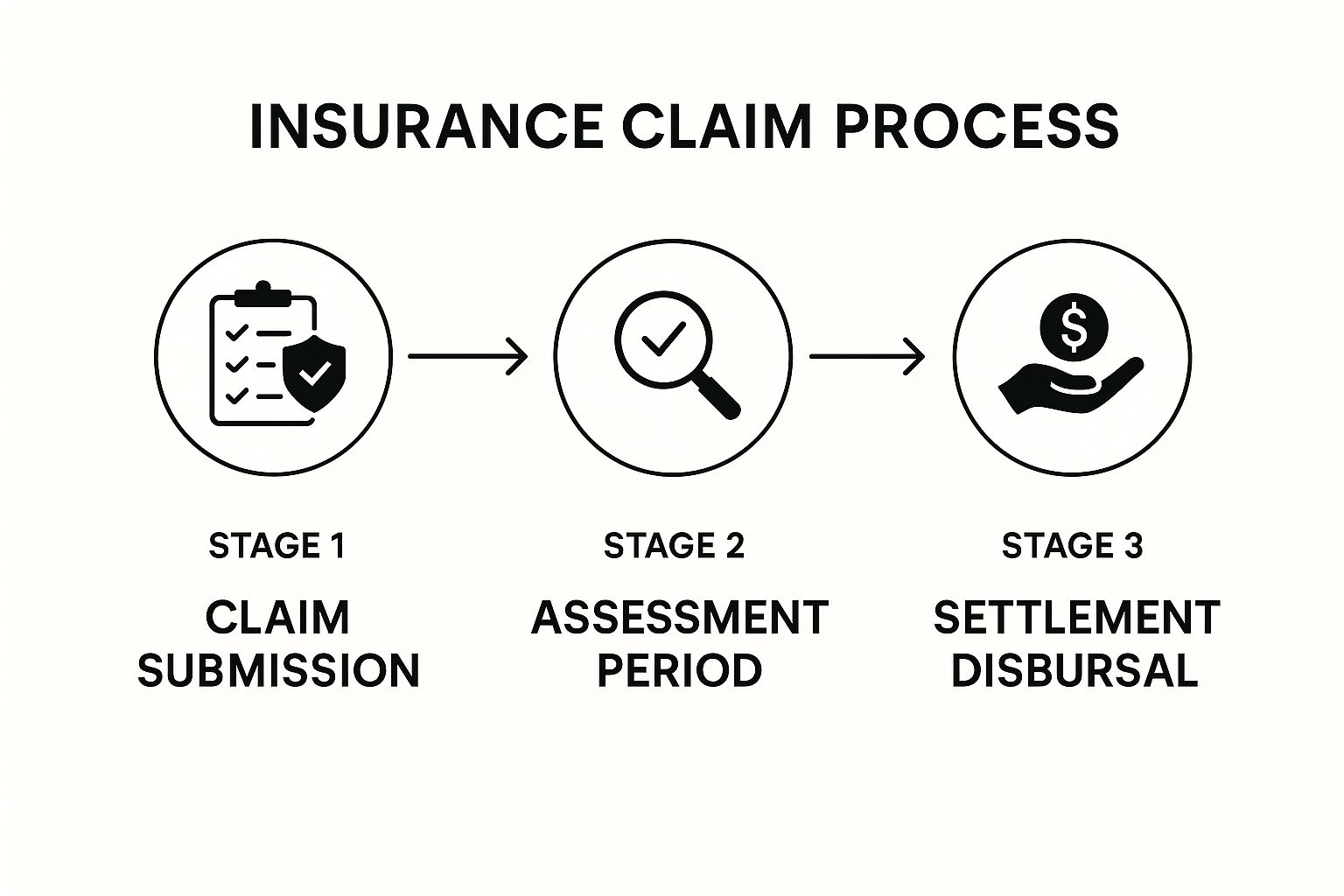Demystifying the Insurance Claim Process Journey

This infographic illustrates the three main stages of an insurance claim: Claim Submission, Assessment Period, and Settlement Disbursal. Navigating these phases effectively is essential for a successful claim. This structured approach helps ensure a smoother, more efficient process.
Understanding the Claim Lifecycle
The insurance claim process begins when you report an incident to your insurer. This initial contact triggers a series of actions that will ultimately determine the outcome of your claim. For instance, a car accident claim requires reporting specific details such as the date, time, location of the accident, and the parties involved. This initial report is reviewed to confirm coverage and begin the assessment process.
This then leads to the next crucial step: gathering and submitting all necessary documentation. For more information on car accident claims, you might find this helpful: How to master the car accident claim process.
The Role of the Adjuster
Once you've reported your claim, an insurance adjuster is assigned to your case. This person investigates the incident and evaluates the damages. Their assessment, based on the evidence you provide and the details of your policy, significantly influences the settlement offer.
It's important to remember that the adjuster's decision isn't final. You have opportunities to negotiate and appeal if you disagree with their evaluation. This process can be complex and often involves ongoing communication, negotiation, and sometimes, escalation.
The Importance of Thorough Documentation
The success of your claim depends heavily on the documentation you provide. Clear photographs, detailed records, and witness testimonies are critical. Maintaining a timeline of events and keeping records of all communication with the adjuster is also crucial.
This organized approach strengthens your claim and gives the insurance company a clear understanding of the incident. Leveraging technology, such as absence management software solutions, can further streamline this process.
The insurance claims services market is constantly evolving. Valued at approximately $184.93 billion in 2024, it's projected to reach $345.97 billion by 2029, with a CAGR of 13.3%. This growth underscores the increasing importance of understanding the claims process. You can find more detailed market statistics here.
To help you understand typical claim timelines, we've provided the table below. It outlines the standard timeframes for various stages of the claims process across different insurance types.
Insurance Claim Process Timeline By Policy Type
This table outlines the typical timeframes for each stage of the claims process across different insurance types
| Insurance Type | Initial Response | Documentation Review | Assessment/Investigation | Decision | Payment Processing |
|---|---|---|---|---|---|
| Auto | 24-48 Hours | 3-5 Business Days | 5-10 Business Days | 2-3 Business Days | 3-5 Business Days |
| Homeowners | 24-48 Hours | 5-7 Business Days | 7-14 Business Days | 3-5 Business Days | 5-7 Business Days |
| Health | 1-2 Business Days | 5-7 Business Days | Varies | 5-10 Business Days | 7-10 Business Days |
This table provides a general overview; actual timelines can vary depending on the complexity of the claim and the specific insurance company. While initial responses are generally prompt across policy types, the assessment and investigation phase can take significantly longer for homeowner's claims compared to auto claims. Health insurance claims often have a more variable investigation period due to the nature of the claim. Understanding these potential timeframes can help you manage your expectations throughout the process.
Building Your Bulletproof Claim Documentation Strategy

A well-organized documentation strategy is the cornerstone of a successful insurance claim. As the policyholder, you control the narrative by providing compelling evidence that drives the outcome. While the insurance adjuster plays a vital role, the evidence you submit ultimately determines the settlement.
Capturing Compelling Visual Evidence
Photographs and videos are powerful tools for substantiating your claim. A methodical approach is essential for capturing effective visuals. Start with wide shots to establish the context of the damage. Then, take close-up photos to highlight specific damage. Time-stamped images provide an accurate record and help maintain a clear timeline of events.
Building a Detailed Incident Chronology
A comprehensive timeline of events is crucial for any insurance claim. Meticulously document every detail from the moment of the incident onward. This detailed chronology helps the adjuster understand the sequence of events and establish causation. For example, in a car insurance claim, record the time, date, location, weather conditions, and any other relevant information.
The Power of Witness Testimony
Independent corroboration significantly strengthens your claim. Secure written statements from witnesses as soon as possible after the incident while memories are fresh. These statements should include their contact information and a detailed account of their observations. Witness testimony adds weight to your claim by providing an objective perspective.
Organizing Medical Documentation (If Applicable)
For claims involving injuries, organized medical records are paramount. This includes doctor’s notes, test results, and medical bills. A clear, chronological record of your treatment and recovery process helps establish the extent of your injuries. Proper documentation substantiates your claim and ensures a smoother process.
Digital Organization: Tips From the Pros
Insurance professionals utilize digital tools to manage large volumes of documentation. Adopt these best practices by creating dedicated folders for each claim and using descriptive file names. Back up everything securely to safeguard your valuable evidence. This systematic approach ensures easy access to information when you need it. Global insurance pricing trends, such as the 3% decline in global commercial insurance rates in Q1 2025, can influence the claims process. You can explore this topic further at Marsh. By implementing these strategies, you create a robust claim documentation package that streamlines the process and increases your likelihood of a favorable outcome. Proactive documentation strengthens your claim and demonstrates your commitment to a fair resolution.
Submission Strategies That Fast-Track Your Insurance Claim
Submitting an insurance claim involves more than just filling out forms. Choosing the right channels and tools can significantly impact the processing time and your final settlement. Understanding the advantages of different submission methods is key to a smoother insurance claim process.
Choosing the Right Submission Channel
The optimal submission method depends on several factors, including the claim type and the urgency of your situation. Here's a look at the most common methods:
-
Mobile Apps: Apps offer convenience, allowing you to upload photos and videos directly from your phone. This can speed up the initial claim stages. However, complex claims may require more detailed information than an app can handle.
-
Online Portals: These platforms provide a more comprehensive submission process. You can often upload documents and communicate directly with your adjuster through a secure online portal.
-
Phone: Calling your insurance provider allows for immediate interaction and clarification. However, submitting extensive documentation over the phone can be less efficient.
-
In-Person: While less common, in-person reporting offers a personalized experience. It usually requires scheduling an appointment and may not be the fastest option.
Selecting the right submission method is crucial for setting the pace from the outset.
Verification Triggers: Expediting vs. Scrutiny
Certain actions can either expedite your claim or trigger additional scrutiny. Providing complete and accurate information upfront, along with all necessary documentation, minimizes delays. Conversely, inconsistencies or missing information can lead to further investigation, potentially prolonging the process. Accurate information is the key to a fast resolution.
Leveraging Digital Claims Tools
Many policyholders overlook valuable digital tools that can streamline the claims process. Real-time tracking features, available through many online portals and mobile apps, offer up-to-date status information. Secure messaging features within these platforms also create a documented communication trail with your adjuster. Using these tools can significantly improve your experience.
Strategic Follow-Up Protocols
Proactive follow-up is essential to keep your claim moving. Regularly checking your claim status online and following up with your adjuster about any delays can prevent your claim from getting lost in processing queues. Understanding your insurer's preferred communication methods can also streamline interactions. You might be interested in: 2025's Best Car Insurance Companies: Expert Reviews and Ratings. By strategically using available resources and following up effectively, you can navigate the process efficiently and maximize your chances of a timely resolution. Proactive communication is key.
Mastering the Adjuster Relationship Dynamic

Your relationship with the claims adjuster has a significant impact on your insurance claim. The adjuster isn't simply a policy representative; they are the gatekeeper to your settlement. Understanding their role and how they operate within the insurance system is essential for a positive claim outcome.
Understanding the Adjuster's Perspective
Adjusters are often assessed on metrics like processing time and settlement amounts. This makes efficiency and cost-containment top priorities. This focus, however, doesn't inherently mean they're working against your claim. By being cooperative and organized, you can expedite the process and build a positive working relationship with the adjuster.
Preparing for the Assessment Visit
The assessment visit is a key stage in the insurance claim process. Proper preparation can greatly influence the adjuster's evaluation. Organize all relevant documentation, such as photos, videos, and witness statements. Prepare a clear, chronological account of the incident to streamline the process. This shows your diligence and helps the adjuster quickly understand your claim.
Decoding Adjuster Questions
The adjuster's questions can reveal valuable insights into their evaluation process. Open-ended questions seeking clarification are generally positive. However, pointed questions challenging aspects of your claim may signal potential issues. Answer honestly and provide supporting documentation for your responses. Documenting each interaction protects your best interests.
Effective Communication Strategies
Maintaining professional and respectful communication throughout the claim process is essential. While advocating for your needs is important, avoid an adversarial approach. Support your requests with evidence and stick to the facts of the case. When discussing damages, for example, reference specific photographs or repair estimates. This objective approach fosters a more productive dialogue. The financial performance of the insurance industry also plays a role. In 2024, insurers' return on equity (ROE) was projected to reach around 10%, increasing to 10.7% in 2025. This emphasis on profitability can influence claims management. Learn more about industry financial performance here.
Escalation Pathways
Sometimes, adjuster relationships can become strained. If you encounter difficulties, it's important to understand the escalation process. Most insurance companies have internal review procedures for disputed claims. Document all communication with the adjuster, including phone calls and emails, to prepare for potential escalation. Knowing your options empowers you to advocate for a fair settlement. A well-managed adjuster relationship can significantly improve the outcome of your insurance claim. By understanding the adjuster's priorities and communicating effectively, you can navigate the claims process more efficiently and work towards a favorable settlement.
Decoding Settlement Offers: What's Fair vs. Lowball

Receiving a settlement offer marks a significant step in the insurance claim process. However, it's essential to remember that the initial offer isn't necessarily the final one. This section explores how to assess an offer and negotiate effectively to ensure a fair settlement.
Understanding How Adjusters Calculate Claim Values
Insurance adjusters use several factors to calculate a claim's value. Depreciation, the decline in an item's value due to age and wear, is a primary factor. They also consider replacement cost, which is the expense of replacing the item with a brand new equivalent. For example, if your five-year-old laptop was stolen, the offer will likely be less than the price of a new, comparable model due to depreciation. The adjuster's understanding and application of your policy's coverage also affects their calculation.
Recognizing Fair vs. Lowball Offers
A fair offer accurately reflects your loss, considering depreciation, replacement costs, and your policy coverage. Conversely, a lowball offer is an attempt to minimize the insurance company's payout. Signs of a lowball offer include significantly undervaluing your losses or omitting key aspects of your claim. Therefore, a thorough evaluation of the offer is critical.
Evaluating Offers Across Insurance Categories
Different insurance types have specific aspects to consider. Auto insurance claims frequently involve assessing vehicle damage, while homeowner's insurance claims can encompass property damage and personal belongings. Effectively evaluating offers requires understanding the nuances of your specific insurance type. This emphasizes the need for tailored negotiation strategies.
To further clarify the varying claim experiences, let's take a look at some common claim settlement scenarios:
Claim Settlement Statistics By Insurance Category
| Insurance Category | Average Settlement Time | Initial Offer vs. Final Settlement | Denial Rate | Success Factors |
|---|---|---|---|---|
| Auto | 4-6 weeks | Initial offers are often 20-30% lower | 10-15% | Clear documentation of damage, police reports, independent appraisals |
| Homeowners | 6-8 weeks | Initial offers can be 10-20% lower | 5-10% | Detailed inventory of lost/damaged items, repair estimates, expert opinions |
| Health | 2-4 weeks | Initial offers might be lower depending on negotiated rates | 15-20% | Accurate medical records, coding, appeals process knowledge |
This table highlights the importance of understanding industry averages and preparing for potential discrepancies between initial and final settlement amounts. The success factors underscore the value of comprehensive documentation in maximizing your claim outcome.
Counteroffer Strategies: Professional Negotiation Tactics
If you believe you’ve received an unfair offer, don't hesitate to make a counteroffer. Substantiating your counteroffer with documentation such as repair estimates, medical bills, or comparable settlement data reinforces your position. Timing also plays a vital role. Being willing to walk away from an unsatisfactory offer can sometimes prompt the insurance company to reassess.
Documentation Leverage Points
Using your carefully gathered documentation is paramount during negotiations. Emphasize specific evidence supporting your counteroffer. If the adjuster's depreciation calculation seems excessive, for instance, provide documentation of the item’s pre-loss condition and current market value for similar items.
Comparative Settlement Data: Knowing the Market
Researching similar settlements provides invaluable context for your negotiations. Resources like online legal databases can reveal the typical settlement range for comparable situations, strengthening your negotiating position.
Timing Considerations: Strategic Negotiation
The timing of your counteroffer can impact the outcome. A prompt, well-supported counteroffer demonstrates your commitment and maintains momentum. However, avoid rushing a counteroffer without adequate preparation. Strategic timing optimizes your negotiating leverage. These combined strategies provide a comprehensive approach to securing a fair insurance claim settlement.
Turning Claim Denials Into Approval Success Stories
A claim denial isn't the end of the road. It's often the start of a new phase in the insurance claim process. Many denials are reversed through a systematic appeal, turning setbacks into victories. This requires understanding why denials happen and how to craft effective appeals.
Dissecting Denial Letters: Identifying Opportunities
The first step in appealing is carefully reviewing the denial letter. Look past the initial disappointment and focus on the specific reasons given. Denials often result from procedural weaknesses, like missing documents or incomplete forms. Other times, it might be a misinterpretation of your coverage. Pinpointing the exact reason for denial is crucial for a strong appeal.
Building a Winning Appeal: The Evidence Hierarchy
Your appeal should present compelling evidence directly addressing the insurer’s stated objections. Some evidence is more impactful than others. Official reports, expert opinions, and documented communication carry more weight than personal stories or general complaints. Imagine an evidence hierarchy: objective documents at the top and subjective statements at the bottom.
Structuring Your Appeal: Addressing Specific Objections
Don't just repeat your initial claim. Instead, address each objection in the denial letter point by point. Provide documentation to refute their arguments and clarify any confusion. For example, if they cite missing medical documentation, include a complete history of your treatment, with doctor’s notes and test results. For more information on car accident claims, see our article: How to master the car accident claim process.
Escalation Pathways: Internal and External Options
Most insurance companies have internal appeal processes. If your initial appeal fails, escalate it within the company. Keep detailed records of all communication and remain professional.
Regulatory Intervention and Legal Considerations
If internal appeals are exhausted, contact your state's insurance regulatory body. They can investigate unfair claim practices and mediate disputes. Sometimes, legal action may be necessary. This often involves consulting with an attorney specializing in insurance law. With an average denial rate of 10% across all insurance types, a well-executed appeal can significantly improve your chances. Each appeal level has specific timelines and response requirements. Understanding these helps you manage expectations and stay in control of the process. Turning a denial into an approval takes a strategic, informed approach. By understanding the reasons and building a compelling appeal, you can increase your chances of getting the coverage you deserve.
Leveraging Tech Innovations in Your Claims Strategy
The insurance claim process is modernizing, providing policyholders with new tools and strategies. Understanding these innovations can give you an advantage, potentially shortening settlement times and maximizing your claim outcome.
AI-Powered Damage Assessment: Clear and Concise Documentation
Imagine an app that not only documents damage but analyzes it, too. AI-powered damage assessment apps are changing how evidence is collected and presented. These apps use algorithms to analyze photos and videos, identifying and quantifying damage with remarkable accuracy. This immediate documentation can speed up the claim process by providing adjusters with readily available information.
Mobile Claim Platforms: Keeping You Informed and in Control
Staying updated on your claim's progress is essential. Mobile claim platforms offer real-time tracking and communication, keeping you connected. These platforms provide instant updates, message alerts, and direct communication with your adjuster. This transparency empowers you to be proactive and address any potential delays quickly. Some platforms even let you upload documents directly, simplifying the submission of additional evidence.
Digital Payment Processing: Settlements Delivered Quickly
Waiting for a settlement check can be a hassle. Digital payment processing is changing that. These technologies allow for secure and near-instantaneous transfer of funds directly to your account. This eliminates the wait associated with traditional checks, getting your settlement to you faster.
Verification Technologies: Safeguarding Legitimate Claims
While technology streamlines legitimate claims, it also combats fraud. Advanced verification technologies analyze claim data for inconsistencies. This proactive approach helps identify potentially fraudulent claims early, preventing delays for legitimate claims. By ensuring the integrity of the claims process, these technologies benefit both policyholders and insurance providers. When dealing with denied claims, understanding escalation procedures can be vital.
Navigating the Evolving Claims Landscape
The insurance claim process has changed significantly. Embracing technology empowers you to navigate the claims ecosystem strategically. By using AI-powered assessments, mobile tracking, digital payments, and robust verification systems, you gain a significant advantage in the claims process. This proactive approach ensures you are well-prepared to manage your claim efficiently and effectively, potentially leading to faster settlements and improved outcomes.
Comments are closed.